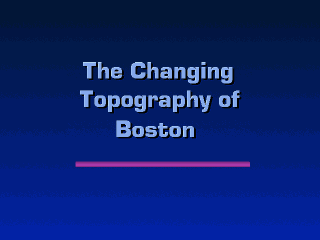

 |
|
The Changing face of
Boston's |
A visitor from 1990 would scarcely recognize the Boston area of 1630. The very landscape has been transformed tremendously in the last 360 years. The land area of Boston has more than tripled since 1630. It may not always be apparent to the driver navigating the narrow streets of Boston, but the creation of this city is one of the great engineering feats of American History.
Note: the following animations are animated gifs, and require no special software or plug-ins; most recent browsers should display the image sequences automatically. They are reduced versions of an earlier presentation.
Slide Show, part 1 |
Slide Show, part 2 |
Slide Show, part 3 |
Slide Show, part 4 |
Slide Show, part 5 |
Slide Show, part 6 |
Slide Show, part 7 |
Slide Show, part 8 |
Slide Show, part 9 |
|||
Examining the pattern of landfill projects reveals much about the history of the city. Boston today is bustling, densely populated, and many of the original landmarks which distinguished the topography of the city have been irrevocably altered, or lost from sight.
Boston Landfill -- Page 2
Boston Landfill -- Page 3
  |
 |

|

Contents of this site |
 Other Architecture Web Links |
Fine Arts Department Home Page |
Boston College
Jeffery Howe, 1996